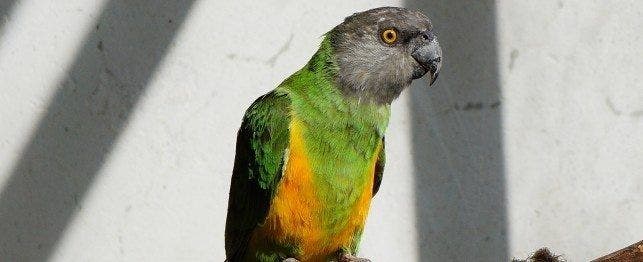
Choosing a Senegal Parrot
Playful and outgoing, Senegal parrots are affectionate while maintaining a dignified sense of independence. They are small stocky colorful parrots, one of the small Poicephalus. Senegal parrots( Poicephalus senegalus) have a large range in western Africa from Guinea and Cameroon to Chad and inhabit lowland forests from dry savannah to mosaic forests. Wild birds are generally found in pairs or small groups and are shy and wary. In captivity, Senegal parrots can live up to 30 years but 15 to 20 years is more common.
Personality and Appearance
Senegals are colorful parrots with a gray head, bright green upper parts, bright yellow/orange abdomen and breast, and green lower neck with a v shaped green patch extending down the chest. They average 9 inches in height and weigh between 125 to 170 grams.
Senegals are playful outgoing birds that love attention. They can be affectionate but are not generally demanding of attention. They tend to become more independent as they reach sexual maturity, 2 to 4 years of age, and adult males may become aggressive during breeding season.
Senegals are excellent pets and they can make good apartment birds as noise is rarely a problem. They are loyal and intelligent, and bond quickly with their owners. While they are not great talkers, they are more adept at sounds than clear speech. They have some limited mimicking ability, and are excellent mimics of household noises. Senegals are generally quieter parrots, but they definitely can let out a screech when excited.
Environmental enrichment is important. They should always be provided with toys, wooden blocks that can be chewed, and branches from non-toxic trees. In order to ensure safety, companion birds should not be allowed unsupervised freedom in the home as they often encounter toxins or dangerous items. Young birds should be socialized to many people and exposed to a variety of situations such as new cages, toys, visits to the veterinarian, handling by friends, wing and nail clips, etc. to avoid fear of novel situations.
Young senegals adapt readily to new surroundings and should be well adapted to many novel experiences at a young age. Adult birds are less adaptable to unfamiliar environments and dietary changes.
Grooming
Routine bathing or showering is vital to maintaining good plumage and skin condition. Birds can be misted and allowed to dry in a warm room or in the sun, or dried with a blow drier. Care should be taken not to clip the wing feathers excessively as heavy bodied birds may fall and injure themselves. Clip only enough so the bird will glide to the floor.
Feeding
Senegal parrots, as well as African greys, appear to use calcium differently than other psittacine species. Birds kept as indoor pets especially tend to develop signs of calcium deficiency that can be a serious health threat. Natural or full spectrum light may also be helpful. Senegal parrots should be fed a formulated (pelleted or extruded) diet as a basis for good nutrition. Senegals should be fed approximately 1 to 2 heaping tablespoons of a formulated diet daily. The diet should be supplemented with approximately the same quantity of fresh fruits and vegetables daily to add variety and psychological enrichment. Treats may be given in small amounts especially as rewards for good behavior. Fresh clean water must be provided every day. Vitamin supplements are not needed for birds that are eating a formulated diet.
Housing
Senegal parrots are very active and should be provided with as large a cage as possible. The cage should have two perches so the birds can move between them. Toys and activities should be provided. Ideally, pet birds should have a cage outdoors to allow exposure to sunlight and fresh air in good weather.
Breeding
Senegal parrots breed well in captivity. Some prolific birds will breed year round but most breed in the winter and early spring. Clutch size is usually three to four eggs.
Senegals will use a vertical 10 inch by 10 inch by 12 inch nest box or an L shaped nest box and do well in a cage at least 4 feet by 4 feet by 4 feet or 3 feet by 3 feet by 6 feet.
Senegal parrots can be very difficult to hand rear from the egg and ideally should be fed by the parents for 1 to 2 weeks. If reared from the egg, they need to be fed very often. There are suitable hand-rearing diets on the market. Senegals wean or fledge at 7 to 9 weeks.
Common Diseases and Disorders
Senegal parrots are relatively healthy birds but are susceptible to the following:
- Chlamydiosis (Psittacosis)
- Psittacine Beak and Feather Disease
- Feather picking
- Respiratory Diseases- Aspergillosis
- Bacterial, viral, Fungal Diseases
- Calcium deficiency disorder
- Toxicities